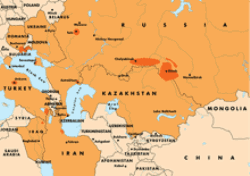Dr. Richard Thomas, an expert at BirdLife International, a global bird-conservation organization, says the annual spring migration of wild birds from their wintering grounds in Africa back to Europe and Asia is just beginning.
"The first birds are arriving in Southern Europe, Spain, and they will gradually move their way north," Thomas says. "It will be quite a few weeks before these birds make it into Central Asia and Russia and so on, because it's very, very cold there still. And the first birds there won't be arriving until April and May."
Thomas also explains that for the Central Asian birds the European route is not the only one. There is another stream of birds returning from wintering grounds in Southern Asia.
"There will be plenty of birds that have been wintering in South Asia, the Indian subcontinent. Lots of waterfowl winter in Bangladesh, for example, and there will be birds that have wintered in Southeast Asia, as well. They will be all heading up into Russia and Siberia over the next few weeks," Thomas notes.
Unsure If Wild Or Domestic Birds Are Carriers
But Thomas says the theory that migratory birds are the originators and main carriers of the bird-flu virus remains unproven. He says scientists still have many questions about how bird flu is spread. And he himself offers a contrarian hypothesis.
Thomas argues that if migratory birds were the principal carriers of the disease, many more of them should have died in Asia, for example. As it is, most bird-flu deaths in Asia occurred in chickens.
"What we've not seen over the last autumn and winter is we haven't seen any dead waterfowl in Southeast Asia, which you would have predicted if it's migrating birds that were carrying the virus to and from Russia, to Southeast Asia," Thomas says. "And similarly, in India, we have not seen any wild birds that have died. They've all been in the commercial poultry factory or backyard poultry factories, as well."
He points out that in Africa, the most recent cases of bird flu in Nigeria, Niger, and Egypt have all involved the commercial poultry industry. Thomas says this raises the question: are migratory birds mainly responsible for spreading the disease to chickens, as is conventionally believed? Or is it the other way around?
Thomas says Chinese poultry exports, mainly by rail to Europe and other parts of Asia, could have played a major role in spreading the virus.
"From the pattern of spread that we saw last autumn the spread [of the disease] just did not follow known migration routes. What it did follow, you can trace it from western China across to Eastern Europe," he says. "And you see a good correlation with the transport routes, with the railway that runs from Lanchow city heading west through Kazakhstan and southern Russia right away across to Romania."
Regardless of whether it was chickens from China or migratory birds that first began spreading bird flu, the likelihood that wild birds this spring could become infected remains high.
Thomas says that when the bird flocks arrive, people should watch for dead birds or birds behaving in a strange manner. They must not shoot them, however, as the flocks would disperse and carry the virus elsewhere. And when collecting the dead birds for local veterinary experts, they should protect themselves and burn the gloves, overalls, and face masks afterward.
Affected Areas

Click on the map for a closer view of the areas within RFE/RL's broadcast region where cases of diseased fowl have been confirmed. Last updated on February 20.
BIRD FLU, or avian influenza, continues to menace scattered areas from East Asia, where the disease first appeared, to Southeastern and Eastern Europe and beyond. Authorities around the world are bracing themselves -- and, more importantly, planning and taking measures to fight the disease wherever it appears.
Stories Of Particular Interest:
Bird-Flu Expert Discusses Issue Of Migratory Birds
Bird Flu: As European Worries Grow, Some See Benefits In Alarm









